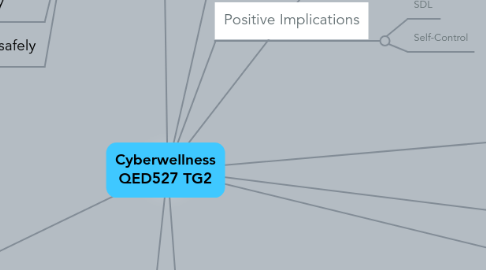
1. Strike a balance beyond the internet.
2. Definition
2.1. -Encompassess concerns around safety and security online.
2.2. -Consider people psychological,social and emotional well being.
2.3. Being responsible, respectful and rational, as well as being alert to scams and how to protect themselves
2.4. cyberwellness - having a healthy mindset in the virtual reality
2.5. use the internet safely
3. Why we need it
3.1. To ensure that internet is a safe medium especially for the young.
3.2. Practise respect and responsibility.
3.3. selection of useful information
3.4. protection of one's mental health/capacity to think
3.5. teenagers and adolescents are still not mature enough to know what is right or wrong. We need a framework to guide them along.
3.6. developing the child’s instinct to protect himself and empower him to take responsibility for his own well-being in cyberspace.
3.7. instill social responsibility
3.8. The students will be aware that there are laws to abide to even online
4. Respect for others
4.1. improved mental health & well-being
5. Increased Efficiency in learning/working
5.1. CL
6. Learn new knowledge
7. being aware of the dangers posed by the internet as it is readily available to everyone
8. Concepts
8.1. Cyberbullying
8.1.1. cyberstalking
8.1.1.1. safety
8.1.2. verbal abuse/vulgarities
8.1.2.1. Lawsuits
8.1.3. Spreading Rumours
8.1.3.1. Reputation tarnished
8.2. cybersex
8.2.1. Wrong ideology of sex leading to adverse psychological effects
8.3. cyberscam
8.3.1. phishing
8.3.2. hacking
8.3.3. fraud/hoaxes
8.3.3.1. chain letters
8.4. game addiction
8.4.1. Affected socially,emotionally and intellectually.
8.4.1.1. Socially - socially withdrawn.
8.4.1.2. Emotionally - distancing oneself from family and friends.
8.4.1.3. Intellectually - Warped idea of what's real vs virtual.
8.4.2. Lose concentration in studies
8.4.2.1. Fail exams
8.4.2.1.1. Drop out of school
8.5. pornography
8.5.1. May lead to sexual assaults
8.6. plagiarism
8.6.1. No real learning taking place
8.7. social network
8.7.1. facebook
8.7.1.1. Dangers of meeting strangers
8.7.1.1.1. Rape
8.7.1.1.2. Murder
8.7.1.1.3. Being conned
8.7.1.1.4. unnecessary harrassment
8.7.1.2. wastage of time which can be more meaningfully spent
8.7.2. Friendster
8.7.3. internet chat
8.7.4. blogging/personal websites
8.7.4.1. flaming (filling in of indecent comments)
8.8. illegal file-sharing/downloading
8.8.1. No incentive for artiste to make money
8.8.2. May get fine
8.9. information overload
8.10. online gambling
8.10.1. Debts
8.10.1.1. Jeopardised family ties
8.10.1.1.1. Suicide
8.10.1.1.2. New node
8.10.1.2. harrassment from loansharks
8.11. computer security
8.12. invasion of privacy (stalking people)
8.13. online shopping
8.13.1. going into debt
9. How to implement it in schools
9.1. Involving parents
9.1.1. parents need to supervise the child during use of computers
9.2. through lessons
9.2.1. cite positive and negatives impact
9.2.2. case studies
9.2.3. starter kits for schools
9.2.4. conduct workshops for students
9.3. exhibitions
9.3.1. schools can invite parents to attend the exhibition with the students so that they can discuss the issue together.
9.4. projects
9.5. counselling
9.5.1. Counsel students who are addicted to online games
9.6. Seminar for Cyber Wellness
9.6.1. Conduct talks for the students
9.6.2. Conduct talks for parents
9.7. Cyber Wellness Guidebooks
9.7.1. pamphlets/brochures
9.8. practices in school computer labs
9.8.1. banning of certain websites (internet security)
